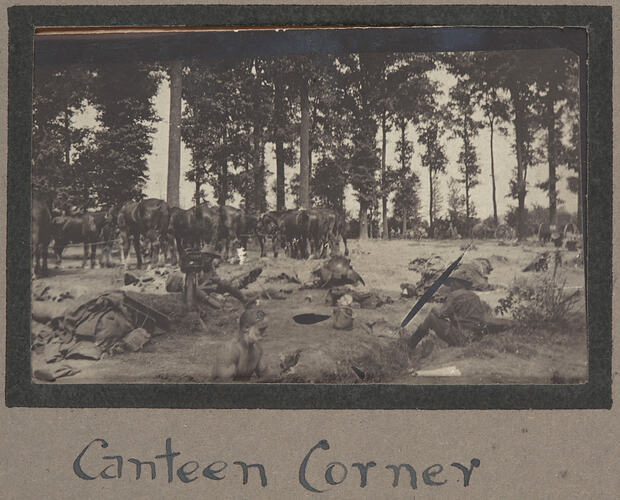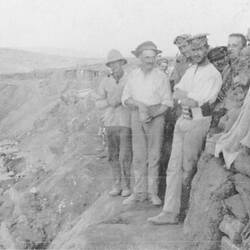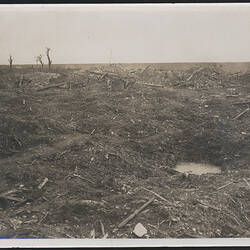Summary
Black and white photographic print depicting a location known as 'Canteen Corner'.
One of 95 black and white, and, sepia toned photographs taken in France during World War I displayed in a photograph album. The album includes a few photographs of enemy prisoners, the war cemetery at Warloy, a wrecked German ambulance and images of the local French people. Most photographs are of Albert and surrounds, so it would seem probable that most were taken during and after the Battle of the Somme (1916). In addition there are also photographs dated 1917. The photographs were taken by Private John Edward Lord, 13th Field Ambulance, and brought back to Australia by him and compiled in an album at the end of the First World War.
The album is one of many souvenirs brought back to Australia after World War I by Lord, and is part of a larger collection of photograph albums, images, documents and World War I memorabilia donated by Lord to Museum Victoria.
Description of Content
The image features a makeshift soldiers camp or rest site in an open field along side a tree lined road. Three soldiers are present in the foreground. Two of the men (left and right of image) appear to be resting while the third soldier (central) is shaving his face. Various equipment, including a billy can, is scattered on the ground around the men. In the left background a group of unsaddled horses have been tethered to a makeshift fence. Further in the background several people and horses and their wagons can be viewed travelling down the road.
Physical Description
Monochrome photograph, mounted in a small, grey photograph album.
Significance
This album appears to have been prepared to 'showcase' the war experiences of John Lord. The album has been carefully prepared and the quality of the photographs is generally good, in comparison to the album ST40491, also compiled by John Lord, which has a number of photographs which are of poor quality, many photographs removed and written in (mostly) illegible pencil. This suggests this album was most probably compiled after the war, with photographs probably gathered from other photograph albums belonging to John Lord.
The subjects of the photographs are of trenches (both German and Allies), horses, camps, farms, graves and cemeteries, civilians, soldiers, churches and other buildings. Many of the photographs were taken around the town of Albert and are dated 1916 and 1917. From this information we can tell that Lord was involved with the Battle of the Somme when these photographs were taken. The Battle of the Somme was fought from north of the Somme river between the towns of Albert and Arras. The Battle began on the 1 July and was called off on the 18 November 1916. The Battle of the Somme is famous for the loss of 58,000 British troops (one third of them killed) on the first day of the battle, 1 July 1916, which to this day remains a one-day record.
Canteen Corner
The exact location of Canteen Corner, depicted in this photograph, is unknown, but various records suggest that it was located within the Messines area in Belgium. The diary of Sydney B. Young, held in the State Library of NSW (MLMSS 985/Item 1), mentions 'canteen Corner, a muddy camp about 2 kilos from Steenwerck' on 31 January 1918. Steenwerck is located in present-day French Flanders, only 13 km from Messen (Messines) in Belgium. Severe fighting took place at Messines in mid 1917, including the successful detonation of explosives beneath the German trenches that were reportedly heard in London, Belfast and Switzerland. It took Australian and British soldiers up to two years to secretly tunnel beneath the German trenches and insert the explosives that became an integral strategy to the Allied success at Messines.
It is unknown whether there was an actual canteen at Canteen Corner. It may have acquired the name simply because it provided a place for rest, meals and recuperation for soldiers, much like an actual canteen does. Other sources state that supplies were sent to Ploegsteert Wood, an area very close to the frontline at Messines, from Canteen Corner daily via a light railway system. This information in conjunction with its close proximity to the battle front would suggest that Canteen Corner was also used as a supply base for Allied forces.
More Information
-
Collection Names
-
Collecting Areas
-
Acquisition Information
Donation from J. Lord, 1986
-
Place & Date Depicted
-
Photographer
Sergeant John Lord, Pont d'Achelles, France, 1916-1917
Image may have been taken by Lord or collected by him for use in this album. -
Format
Photograph, Monochrome
-
Inscriptions
Handwritten in ink on matt directly below photograph: 'Canteen Corner'
-
Classification
-
Category
-
Discipline
-
Type of item
-
Image Dimensions - Photograph
60 mm (Width), 45 mm (Height)
-
Image Dimensions - Photograph album page
195 mm (Width), 145 mm (Height)
-
Keywords
Australian Army, Militaria: Australian, Military Memorabilia, Shaving, Souvenirs, Wars & Conflicts, World War I, 1914-1918


